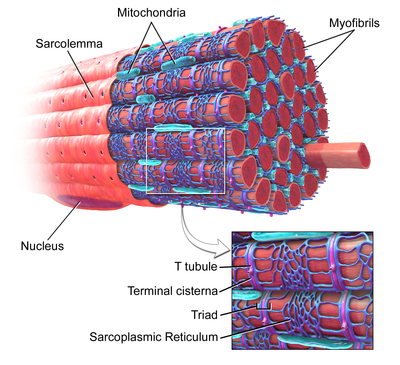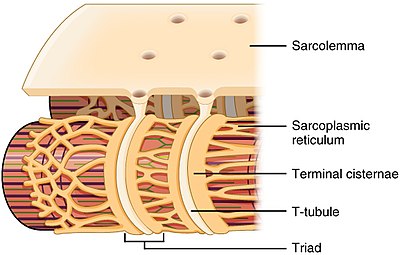Transverse tubules
| T-tubule | |
|---|---|

Skeletal muscle, with T-tubule labelled in zoomed in image.
|
|

T-tubule structure and relationship to the sarcoplasmic reticulum in skeletal muscle
|
|
| Details | |
| Part of | Cell membrane of Skeletal muscle and cardiac muscle cells. |
| Identifiers | |
| Latin | tubulus transversus |
| Code |
TH H2.00.05.2.01018 TH H2.00.05.2.02013 |
| TH | H2.00.05.2.01018, H2.00.05.2.02013 |
|
Anatomical terminology
[]
|
|
Transverse tubules (T-tubules) are extensions of the cell membrane that penetrate into the centre of skeletal and cardiac muscle cells. With membranes that contain large concentrations of ion channels, transporters, and pumps, T-tubules permit rapid transmission of the action potential into the cell, and also play an important role in regulating cellular calcium concentration. Through these mechanisms, T-tubules allow heart muscle cells to contract more forcefully by synchronising calcium release throughout the cell. T-tubule structure may be affected by disease, potentially contributing to heart failure and arrhythmias. Although these structures were first seen in 1897, research into T-tubule biology is ongoing.
T-tubules are tubules formed from the same phospholipid bilayer as the surface membrane or sarcolemma of skeletal or cardiac muscle cells. They connect directly with the sarcolemma at one end before travelling deep within the cell, forming a network of tubules with sections running both perpendicular (transverse) to and parallel (axially) to the sarcolemma. Due to this complex orientation, some refer to T-tubules as the transverse-axial tubular system. The inside or lumen of the T-tubule is open at the cell surface, meaning that the T-tubule is filled with fluid containing the same constituents as the solution that surrounds the cell (the extracellular fluid). Rather than being just a passive connecting tube, the membrane which forms T-tubules is highly active, being studded with proteins including L-type calcium channels, sodium-calcium exchangers, calcium ATPases and Beta adrenoceptors.
T-tubules are found in both atrial and ventricular cardiac muscle cells (cardiomyocytes), in which they develop in the first few weeks of life. They are found in ventricular muscle cells in most species, and in atrial muscle cells from large mammals. In cardiac muscle cells, T-tubules are between 20 and 450 nanometers in diameter and are usually located in regions called Z-discs where the actin filaments anchor within the cell. T-tubules within the heart are closely associated with the intracellular calcium store known as the sarcoplasmic reticulum in specific regions referred to as terminal cisternae. The association of the T-tubule with a terminal cistern is known as a dyad.
...
Wikipedia
